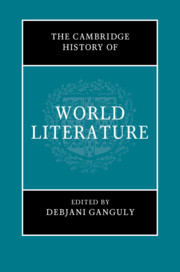Book contents
- The Cambridge History of World Literature
- The Cambridge History of World Literature
- Copyright page
- Contents
- Figures
- Contributors
- Acknowledgements
- Introduction
- Part I Genealogies
- Part II Thinking the World
- Part III Transregional Worlding
- Part IV Cartographic Shifts
- Part V World Literature and Translation
- Part VI Poetics, Genre, Intermediality
- Part VII Scales, Polysystems, Canons
- 36 Spatial Scale and the Urban Everyday: The Physiology as a Traveling Genre (Paris, St. Petersburg, Tiflis)
- 37 Imaginative Geographies in the Medieval Islamic Republic of Letters
- 38 The Anthology as the Canon of World Literature
- 39 Data Worlds: Patterns, Structures, Libraries
- Part VIII Modes of Reading and Circulation
- Part IX The Worldly and the Planetary
- Index
- References
37 - Imaginative Geographies in the Medieval Islamic Republic of Letters
from Part VII - Scales, Polysystems, Canons
Published online by Cambridge University Press: 17 August 2021
- The Cambridge History of World Literature
- The Cambridge History of World Literature
- Copyright page
- Contents
- Figures
- Contributors
- Acknowledgements
- Introduction
- Part I Genealogies
- Part II Thinking the World
- Part III Transregional Worlding
- Part IV Cartographic Shifts
- Part V World Literature and Translation
- Part VI Poetics, Genre, Intermediality
- Part VII Scales, Polysystems, Canons
- 36 Spatial Scale and the Urban Everyday: The Physiology as a Traveling Genre (Paris, St. Petersburg, Tiflis)
- 37 Imaginative Geographies in the Medieval Islamic Republic of Letters
- 38 The Anthology as the Canon of World Literature
- 39 Data Worlds: Patterns, Structures, Libraries
- Part VIII Modes of Reading and Circulation
- Part IX The Worldly and the Planetary
- Index
- References
Summary
This contribution prepares for a lengthy study of imaginative geography, and its metanarrative as an empowering narrative strategy. The classical and medieval Arab-Islamic geographer was not necessarily a geographer per se. Philologists often use their knowledge of space to construct a wide ranging inquiry that happened to serve generations of geographers. A close reading in a number of explanatory commentaries and marginalia helps to perceive the turns and fluctuations in geographic genealogies in relation to lands outside the Islamic core. The self-conscious geographer needs not only to define method or mode, but also to vindicate a departure, and claim or deny antecedent authority and source material. A republic of letters finds substantiation and root in these insights, and explanations, and complements other explorations in compendiums, encyclopedic knowledge, and literary or broad cultural exchange.
- Type
- Chapter
- Information
- The Cambridge History of World Literature , pp. 730 - 748Publisher: Cambridge University PressPrint publication year: 2021



